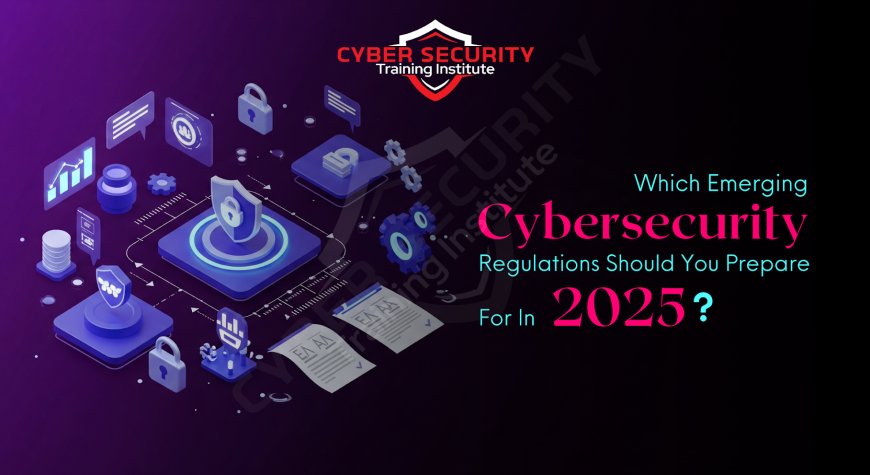Which Emerging Cybersecurity Regulations Should You Prepare for in 2025?
Stay ahead in 2025 by understanding the cybersecurity regulations shaping the global digital economy. This blog explores major laws like the EU Cyber Resilience Act, India’s DPDP Act, and U.S. AI governance frameworks, offering sector-specific insights and enterprise strategies for compliance. From AI transparency to data protection, discover what your organization must do to remain secure, compliant, and competitive.

Table of Contents
- Introduction
- Why 2025 Is a Pivotal Year for Cybersecurity Regulation
- Key Global Regulations on the Horizon
- Sector-Specific Compliance Trends
- AI and Data Privacy: A Regulatory Crossroad
- Implications for Enterprises
- Conclusion
- FAQ
Introduction
The regulatory landscape for cybersecurity in 2025 is rapidly evolving in response to growing threats, advanced technologies, and geopolitical tensions. Organizations must prepare for stricter data governance rules, AI accountability frameworks, and industry-specific security mandates. This blog explores the most significant emerging cybersecurity regulations you need to watch for and adapt to this year.
Why 2025 Is a Pivotal Year for Cybersecurity Regulation
With cyberattacks growing more sophisticated and AI tools now a double-edged sword, 2025 is shaping up as a year where governments move swiftly to implement tighter controls. Recent breaches involving critical infrastructure, healthcare systems, and cross-border data flow have triggered aggressive policymaking. Regulatory bodies are now more focused on not just compliance, but proactive cyber resilience.
Key Global Regulations on the Horizon
Here are the major global and national-level regulations emerging in 2025:
| Regulation Name | Region | Focus Area | Expected Impact |
|---|---|---|---|
| EU Cyber Resilience Act (CRA) | European Union | Secure product design and supply chain integrity | Mandatory cyber standards for manufacturers |
| U.S. AI Accountability Framework | United States | AI transparency and responsible deployment | New mandates for auditing AI-based tools |
| India Digital Personal Data Protection Act (DPDP) | India | Personal data rights and breach reporting | Heavy fines for non-compliance and delayed reporting |
| China Cybersecurity Review Measures (Revised) | China | Cross-border data transfer and tech scrutiny | Greater oversight on foreign software and hardware |
| Global Healthcare Cyber Safety Standard | International (ISO/WHO) | Medical device and patient data protection | New international certification requirements |
Sector-Specific Compliance Trends
In addition to broad policies, sector-focused regulations are tightening:
- Finance: Updates to PCI DSS and SEC disclosure rules require real-time incident reporting.
- Healthcare: HIPAA modernization and ISO 81001 demand tighter medical data controls.
- Energy: NERC CIP revisions aim to harden operational technology (OT) environments.
AI and Data Privacy: A Regulatory Crossroad
The convergence of AI, big data, and privacy laws has prompted specific guidance around:
- AI explainability: Companies must prove that AI-driven decisions are auditable.
- Bias detection: Governments demand systems that can detect and mitigate algorithmic bias.
- Data residency: Cross-border data flow must comply with new jurisdictional frameworks.
Implications for Enterprises
To stay compliant and competitive, organizations should:
- Appoint dedicated compliance officers for emerging global laws.
- Automate risk assessments to meet real-time reporting requirements.
- Implement AI governance frameworks to align with new transparency laws.
Early adaptation can also serve as a competitive advantage in regulated markets.
Conclusion
2025 will not just be about stronger cybersecurity tools—it will be about proving security and responsibility through compliance. With legislation tightening across sectors and borders, organizations that treat cybersecurity regulation as a strategic priority will be far better positioned to operate securely and gain trust in an increasingly regulated digital world.
FAQ
What is the EU Cyber Resilience Act?
The EU Cyber Resilience Act mandates secure-by-design product development and emphasizes vulnerability management and supply chain assurance for connected devices.
How will the U.S. AI Accountability Framework affect businesses?
It requires companies deploying AI to ensure explainability, fairness, and auditability—especially when impacting public-facing or critical decisions.
Is India’s DPDP Act already in force?
Yes, the Digital Personal Data Protection Act is enforceable and introduces stringent data consent, breach notification, and penalty provisions.
Why are healthcare regulations becoming stricter in 2025?
Due to increasing attacks on hospitals and medical devices, global agencies are enforcing tighter safety and compliance standards.
Are AI-based tools subject to new regulations?
Yes, AI systems must now meet regulatory expectations for transparency, ethical use, and data protection, particularly under U.S. and EU laws.
How can enterprises prepare for emerging compliance mandates?
By deploying governance, risk, and compliance (GRC) tools, hiring cyber-legal advisors, and staying engaged with updates from global regulators.
Will cross-border data transfers face more restrictions?
Yes, especially under the EU GDPR, China’s cybersecurity laws, and India’s DPDP Act, which all emphasize data localization and oversight.
Which industries are most impacted by these regulations?
Finance, healthcare, manufacturing, and AI-heavy sectors face the brunt of regulatory scrutiny in 2025.
What happens if companies fail to comply?
Non-compliance can result in heavy fines, operational restrictions, reputational damage, and even criminal liability in certain jurisdictions.
Do these regulations also apply to small businesses?
Yes, although thresholds and reporting timelines may vary, all businesses handling sensitive data or deploying AI should be aware of their obligations.
What's Your Reaction?
 Like
0
Like
0
 Dislike
0
Dislike
0
 Love
0
Love
0
 Funny
0
Funny
0
 Angry
0
Angry
0
 Sad
0
Sad
0
 Wow
0
Wow
0
















